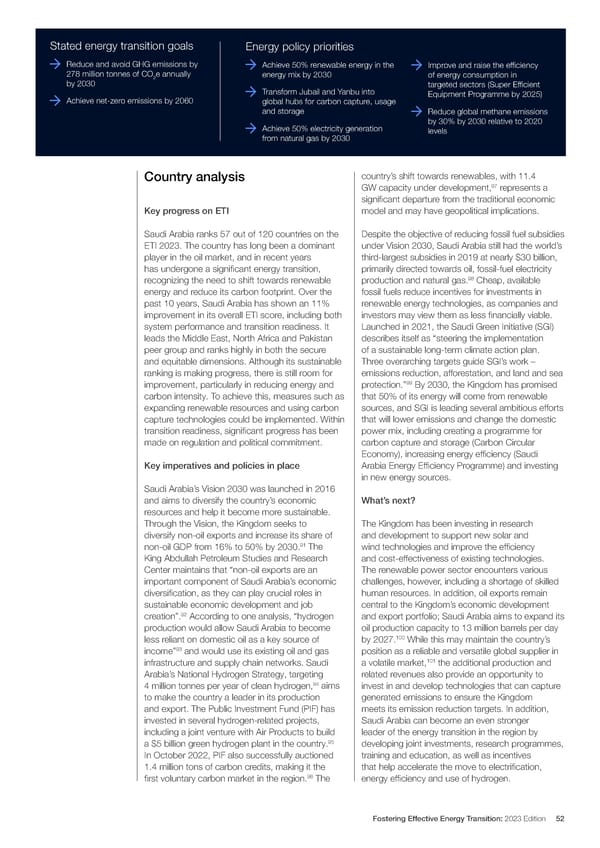Stated energy transition goals Energy policy priorities Reduce and avoid GHG emissions by Achieve 50% renewable energy in the Improve and raise the ef昀椀ciency 278 million tonnes of CO e annually energy mix by 2030 of energy consumption in by 2030 2 Transform Jubail and Yanbu into targeted sectors (Super Ef昀椀cient Achieve net-zero emissions by 2060 Equipment Programme by 2025) global hubs for carbon capture, usage and storage Reduce global methane emissions Achieve 50% electricity generation by 30% by 2030 relative to 2020 levels from natural gas by 2030 country’s shift towards renewables, with 11.4 Country analysis GW capacity under development,97 represents a signi昀椀cant departure from the traditional economic Key progress on ETI model and may have geopolitical implications. Saudi Arabia ranks 57 out of 120 countries on the Despite the objective of reducing fossil fuel subsidies ETI 2023. The country has long been a dominant under Vision 2030, Saudi Arabia still had the world’s player in the oil market, and in recent years third-largest subsidies in 2019 at nearly $30 billion, has undergone a signi昀椀cant energy transition, primarily directed towards oil, fossil-fuel electricity 98 recognizing the need to shift towards renewable production and natural gas. Cheap, available energy and reduce its carbon footprint. Over the fossil fuels reduce incentives for investments in past 10 years, Saudi Arabia has shown an 11% renewable energy technologies, as companies and improvement in its overall ETI score, including both investors may view them as less 昀椀nancially viable. system performance and transition readiness. It Launched in 2021, the Saudi Green Initiative (SGI) leads the Middle East, North Africa and Pakistan describes itself as “steering the implementation peer group and ranks highly in both the secure of a sustainable long-term climate action plan. and equitable dimensions. Although its sustainable Three overarching targets guide SGI’s work – ranking is making progress, there is still room for emissions reduction, afforestation, and land and sea improvement, particularly in reducing energy and protection.”99 By 2030, the Kingdom has promised carbon intensity. To achieve this, measures such as that 50% of its energy will come from renewable expanding renewable resources and using carbon sources, and SGI is leading several ambitious efforts capture technologies could be implemented. Within that will lower emissions and change the domestic transition readiness, signi昀椀cant progress has been power mix, including creating a programme for made on regulation and political commitment. carbon capture and storage (Carbon Circular Economy), increasing energy ef昀椀ciency (Saudi Key imperatives and policies in place Arabia Energy Ef昀椀ciency Programme) and investing in new energy sources. Saudi Arabia’s Vision 2030 was launched in 2016 and aims to diversify the country’s economic What’s next? resources and help it become more sustainable. Through the Vision, the Kingdom seeks to The Kingdom has been investing in research diversify non-oil exports and increase its share of and development to support new solar and 91 The wind technologies and improve the ef昀椀ciency non-oil GDP from 16% to 50% by 2030. King Abdullah Petroleum Studies and Research and cost-effectiveness of existing technologies. Center maintains that “non-oil exports are an The renewable power sector encounters various important component of Saudi Arabia’s economic challenges, however, including a shortage of skilled diversi昀椀cation, as they can play crucial roles in human resources. In addition, oil exports remain sustainable economic development and job central to the Kingdom’s economic development creation”.92 According to one analysis, “hydrogen and export portfolio; Saudi Arabia aims to expand its production would allow Saudi Arabia to become oil production capacity to 13 million barrels per day less reliant on domestic oil as a key source of 100 While this may maintain the country’s by 2027. 93 income” and would use its existing oil and gas position as a reliable and versatile global supplier in infrastructure and supply chain networks. Saudi 101 the additional production and a volatile market, Arabia’s National Hydrogen Strategy, targeting related revenues also provide an opportunity to 94 aims 4 million tonnes per year of clean hydrogen, invest in and develop technologies that can capture to make the country a leader in its production generated emissions to ensure the Kingdom and export. The Public Investment Fund (PIF) has meets its emission reduction targets. In addition, invested in several hydrogen-related projects, Saudi Arabia can become an even stronger including a joint venture with Air Products to build leader of the energy transition in the region by a $5 billion green hydrogen plant in the country.95 developing joint investments, research programmes, In October 2022, PIF also successfully auctioned training and education, as well as incentives 1.4 million tons of carbon credits, making it the that help accelerate the move to electri昀椀cation, 96 昀椀rst voluntary carbon market in the region. The energy ef昀椀ciency and use of hydrogen. Fostering Effective Energy Transition: 2023 Edition 52
 Fostering Effective Energy Transition 2023 Page 51 Page 53
Fostering Effective Energy Transition 2023 Page 51 Page 53